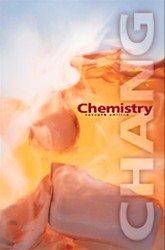|
 |  Chemistry, 7/e Raymond Chang,
Williams College
Organic Chemistry
Internet ExercisesSpectrum database
(http://www.speclab.com/compound/chemabc.htm)
- There are three structural isomers called dichlorobenzene.
Use the Spectrum database at http://www.speclab.com/compound/chemabc.htm
to:
- Determine which of the three isomers is
used as a fumigant and a moth protectant.
- If the isomer used as a fumigant can be
detected by smell, how much of the compound would be present in a room
that measures 10' by 10' by 8'?
|
 |  |  | Molecular Viewing Gallery
(http://www.dcu.ie/%7Echemist/pratt/pdb/gallery.htm)
- 3D models are useful because they allow you
to see much more of the 3-dimensional aspects of a molecule than is obvious
with a structural formula such as HOCH2CH(CH3)CH2CH3.
The molecular viewing gallery allows you to see a number of molecules in 3D
perspective and to rotate them (you will need the plug-in Chime). It is important
to remember, however, that the conformation of atoms that you see in these
molecule is not static; that is, rotation of groups about single bonds can
lead to an arrangement of atoms that is not the same as the picture you see.
Let's go to the Molecular Viewing Gallery at http://www.dcu.ie/%7Echemist/pratt/pdb/gallery.htm,
and click on 2-methylbutan-1-ol.
- First, write a structural formula of the
type shown above for this compound.
- Does this compound exhibit optical isomerism?
- Does this compound exhibit geometrical
isomerism?
- Rotate the molecule until the OH group
is on the right-hand side and vertical. Now draw a structure for the molecule
as it would appear after you have rotated the ethyl group around the single
bond between the second and third carbons. Is the number 4 (end) carbon
closer to the oxygen now or farther away? Is this new arrangement of atoms
a structural isomer of the compound as it is shown or is it a conformation?
- Now write a structural formula for the
structural isomer of this compound.
|
 |  |  | ChemFinder
(http://chemfinder.camsoft.com/)
- Using ChemFinder at http://chemfinder.camsoft.com/,
answer the following about nicotene:
- Is the compound cyclic or acyclic?
- Is it an acid or a base or likely to be
neutral in aqueous solution?
- If nicotene were dissolved in a solution
of HCl, what site, if any, would the proton attack?
- How does nicotene find its way into some
sources of drinking water?
|
 |  |  | Spectrum database
(http://www.speclab.com/compound/chemabc.htm)
- Using Spectrum database at http://www.speclab.com/compound/chemabc.htm,
answer the following about nicotene:
- Is the compound cyclic or acyclic?
- Is it an acid or a base or likely to be
neutral in aqueous solution?
- If nicotene were dissolved in a solution
of HCl, what site, if any, would the proton attack?
- How does nicotene find its way into some
sources of drinking water?
|
|
|



 2002 McGraw-Hill Higher Education
2002 McGraw-Hill Higher Education

 2002 McGraw-Hill Higher Education
2002 McGraw-Hill Higher Education